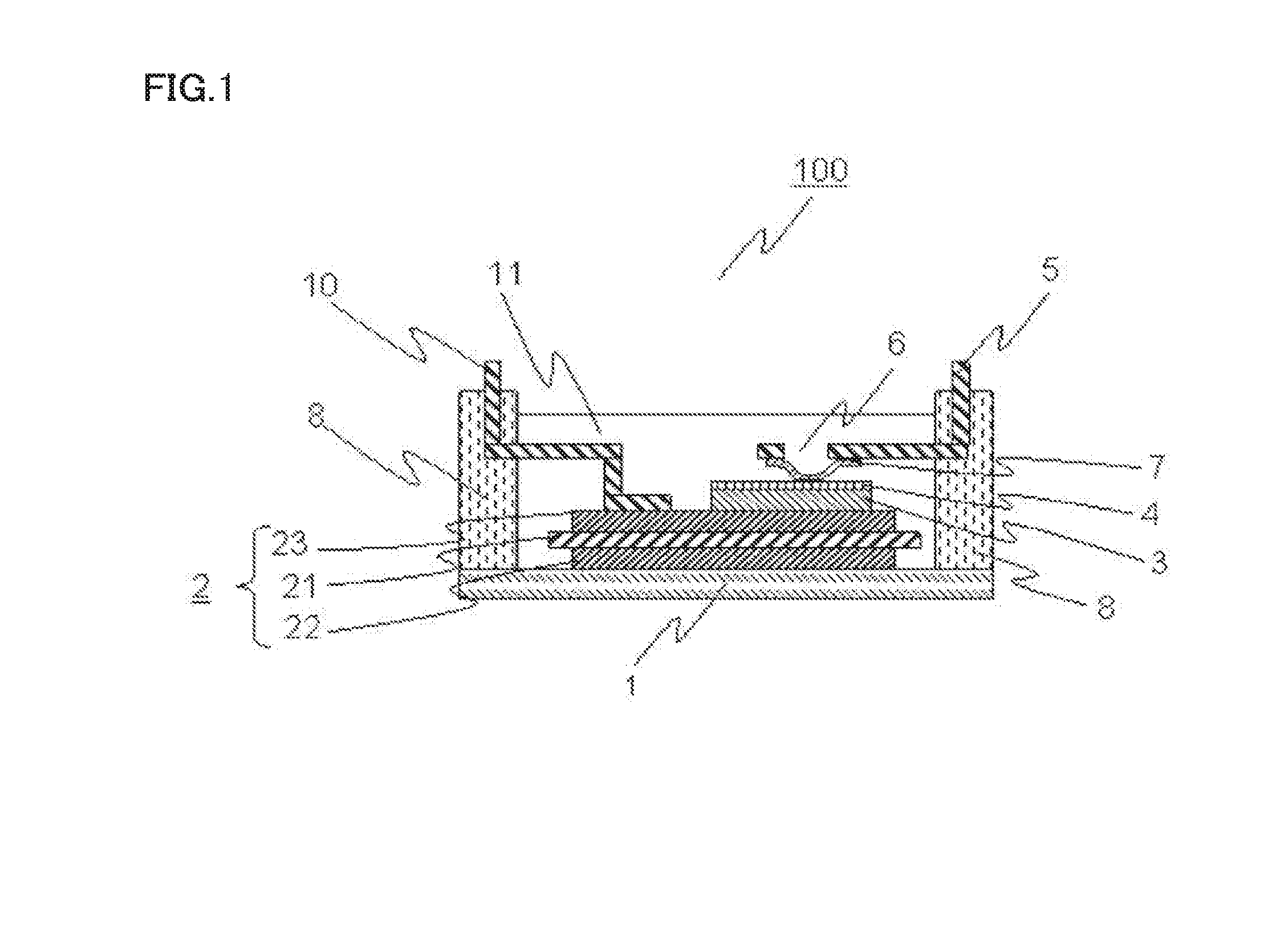Power module and method of manufacturing power module
- Summary
- Abstract
- Description
- Claims
- Application Information
AI Technical Summary
Benefits of technology
Problems solved by technology
Method used
Image
Examples
first embodiment
[0025]FIG. 1 is a schematic cross-sectional structure diagram of a power module in a first embodiment of the present invention. Power module 100 in FIG. 1 includes a heat-dissipation metal base plate 1, an insulating substrate 2 which is a first base portion, a power semiconductor device 3 which is a second base portion, a surface electrode 4, main terminals 5, 10 which are each a conductor portion, an opening 6, a bonding ribbon 7 which is an interconnect portion, a case 8, and a sealant resin 11.
[0026]Insulating substrate 2 is joined onto heat-dissipation metal base plate 1 with solder or the like (not shown). Insulating substrate 2 includes an insulating layer 21 and metal plates 22, 23. Insulating substrate 2 has a structure in which metal plates 22, 23 of copper or the like are bonded to respective opposite sides of insulating layer 21 formed of a ceramic material such as aluminum oxide, aluminum nitride, or silicon nitride, or formed of epoxy resin or the like. On the front-si...
second embodiment
[0040]A second embodiment differs from the first embodiment in that, while main terminal 5 used in the first embodiment has opening 6, main terminal 5 of the second embodiment does not have opening 6, and in that one end of bonding ribbon 7 is ultrasonically welded to the surface of main terminal 5 facing power semiconductor device 3 and the other end of bonding ribbon 7 is ultrasonically welded to surface electrode 4 of power semiconductor device 3 in the second embodiment. Thus, the distance across which bonding ribbon 7 joins main terminal 5 to surface electrode 4 is short, and therefore, the amount of bonding ribbon 7 used for joining can be reduced.
[0041]FIG. 4 is a schematic cross-sectional structure diagram of an electrode portion of a power module in the second embodiment of the present invention. In FIG. 4, a joint portion between power semiconductor device 3 and main terminal 5 includes power semiconductor device 3, surface electrode 4, main terminal 5, and bonding ribbon ...
third embodiment
[0046]A third embodiment differs from the first embodiment in that, while solder joining is used for the joint portion between main terminal 10 and insulating substrate 2 in the first embodiment, opening 6 is formed in main terminal 10 like main terminal 5 and main terminal 10 is joined to insulating substrate 2 via bonding ribbon 7 in the third embodiment. Thus, the joint for main terminal 5 and the joint for main terminal 10 can be formed in the same step and the number of steps can be reduced. Moreover, the reliability of the joint between main terminal 10 and insulating substrate 2 can be improved.
[0047]FIG. 6 is a schematic cross-sectional structure diagram of a power module in the third embodiment of the present invention. Power module 200 in FIG. 6 includes heat-dissipation metal base plate 1, insulating substrate 2, power semiconductor device 3, surface electrode 4, main terminals 5, 10, opening 6, bonding ribbon 7, case 8, and sealant resin 11. While main terminal 10 is joi...
PUM
 Login to View More
Login to View More Abstract
Description
Claims
Application Information
 Login to View More
Login to View More - R&D
- Intellectual Property
- Life Sciences
- Materials
- Tech Scout
- Unparalleled Data Quality
- Higher Quality Content
- 60% Fewer Hallucinations
Browse by: Latest US Patents, China's latest patents, Technical Efficacy Thesaurus, Application Domain, Technology Topic, Popular Technical Reports.
© 2025 PatSnap. All rights reserved.Legal|Privacy policy|Modern Slavery Act Transparency Statement|Sitemap|About US| Contact US: help@patsnap.com



